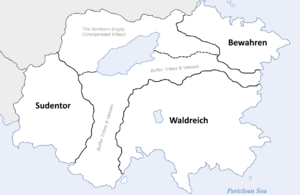War of the Three Nations
This article is incomplete because it is pending further input from participants, or it is a work-in-progress by one author. Please comment on this article's talk page to share your input, comments and questions. Note: To contribute to this article, you may need to seek help from the author(s) of this page. |
| War of the Three Nations | ||||||||||
|---|---|---|---|---|---|---|---|---|---|---|
 Political state of Brumen, circa 750 CE | ||||||||||
| ||||||||||
| Belligerents | ||||||||||
|
Vassals:
|
Vassal:
|
Vassals:
| ||||||||
| Commanders and leaders | ||||||||||
|
|
| ||||||||
| Strength | ||||||||||
| TBD | TBD | TBD | ||||||||
| Casualties and losses | ||||||||||
| TBD | ||||||||||
The War of the Three Nations was an armed conflict that took place between the Gothic powers of Waldreich, Sudentor & Bewahren from 581 CE until 833 CE. The war was largely caused due to the power vacuum left by the Latin Empire after their expulsion in 510 CE. The expulsion of Latium from Brumen was a turning point in Brumenese history due to the huge power vacuum left by the Latins. The Allied Gothic Tribes was a loose alliance between many tribes, some small and some large enough to the point they have multiple vassals underneath them, but all were by a council of the most powerful Chieftains. It was formed from the various Gothic rebels that opposed Latin rule. There were talks to form a more permanent confederation between the tribes but none of the chieftains could agree on how to achieve said confederation.
After one year of stalled diplomatic talks, in 511 CE a group of Chieftains proclaimed the establishment of the Waldreich Confederacy and unilaterally laid claim to dominion over all Gothic tribes. This marked the de facto collapse of the Allied Gothic Tribes. Two months after Waldreich's proclamation, Gothic tribes that had occupied the western lands proclaimed and established the Union of Sudentor. Up until 580 CE Waldreich & Sudentor engaged in a cold war as both states sought to absorb as much of the unaligned gothic tribes scattered throughout Brumenese lands. Some were annexed while others either voluntarily or forced to swear their allegiance to one of the two powers. By 580 CE tension between Waldreich & Sudentor reached a historic low point where, in an attempt to tip the balance of power in its favor, the former supported a conspiracy usurp a vassal of Sudentor. The plot was uncovered Sudentor demanded reparations by Waldreich. Peace talks fails to bring any resolution to the dispute and by 581 CE Waldreich began the invasion of Sudentor.
While the initial start of the campaign saw a string of victories for Waldreich, as Waldreich’s forces went deeper into Sudentor their advances eventually ground to a halt. This was largely due to the Sudentor's defense in depth strategy. Sacrificing parts of its territory to Waldreich but reinforcing their core territories. At around the same time various Chieftains who had grown weary of Waldreich’s aggressiveness began plotting a secessionist movement in the east. In 590 CE the Kingdom of Bewahren was proclaimed in the east, opening an eastern theater of war and forcing Waldreich to redirect some of its forces towards the east. Facing a war in two theaters, Waldreich could no longer advance in both the western and eastern front lines. By 596 CE all front lines stabilized and large scale military campaigns have stopped. However no peace treaty or armistice was signed. Vassals were established to act as buffer states between Waldreich, Sudentor & Bewahren. For the next 200 years the three gothic nations were locked in a protracted frozen conflict, neither power able to gain any significant advantage over the other. Most armed conflicts in this period of time took place between the vassal tribes of Waldreich, Sudentor & Bewahren. An armistice would eventually be signed in 833 CE by the three Gothic nations due to the rise of Viragstag in the northern shores of lake Bluhen.